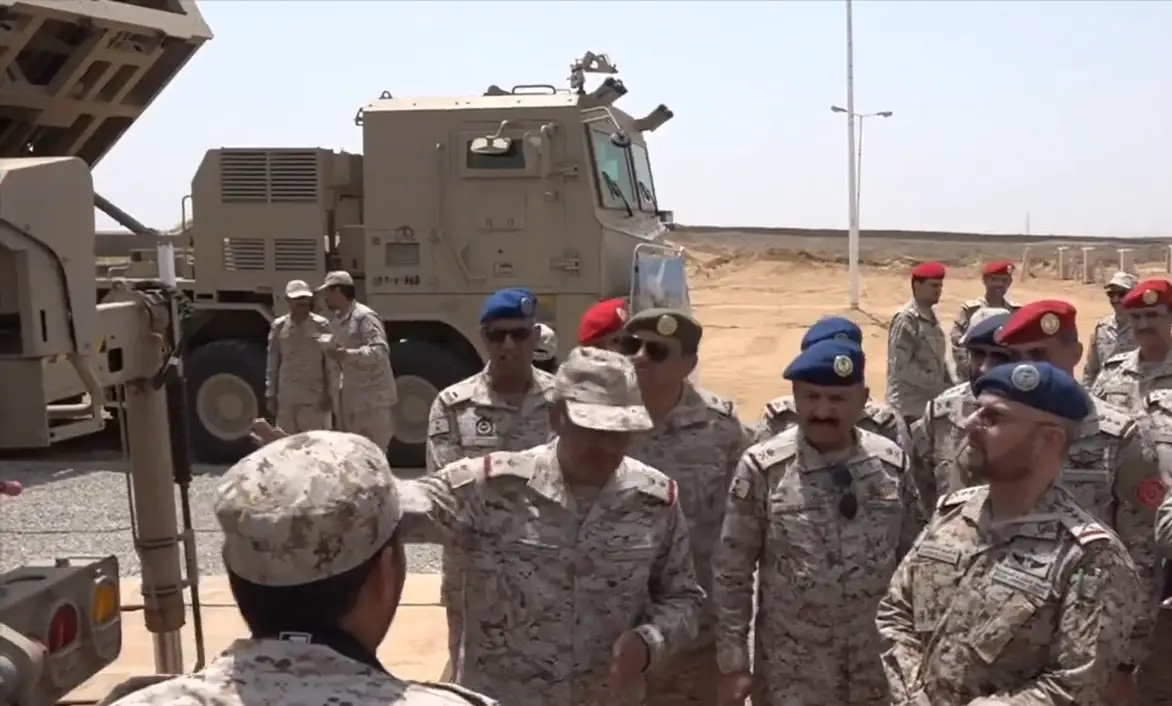The Royal Saudi Land Forces (RSLF) appear to have acquired and deployed South Korea’s K239 Chunmoo multiple launch rocket system (MLRS) on the border with Yemen. The multiple launch rocket systems were seen for the first time on Saudi soil during last week’s visit of Fayyad bin Hamed al-Ruwaili, the chief of the General Staff, to military units deployed on the border. During the visit, Lt Gen Fayyad met personnel from Bahrain and the United Arab Emirates (UAE), which are part of the Saudi-led coalition fighting Yemen’s Houthi rebels. The UAE was earlier the only known export customer for the Chun-Moos, but the MRLs clearly had the RSLF markings. The visit included stops in the Jizan and Najran sectors and released a video clip of being shown at least two Chun-Moo MRLs and an ammunition resupply vehicle.
The K239 Chunmoo is a multiple launch rocket system (MLRS) system developed in 2013 to replace the aging K136 Kooryong of the South Korean military. The K239 Chunmoo is a self-propelled multiple rocket launcher (MRL) capable of firing several different guided or unguided artillery rockets. The K239 is capable of launching K33 131 mm rockets, but not 130 mm rockets (such as the K30, K37 and K38), which are used in the existing K136 Kooryong rocket artillery system. Development of the K239 Chunmoo began in 2009 and was completed in late 2013. South Korea’s Defense Acquisition Program Administration (DAPA) spent 131.4 billion won ($112.4 million) on the project to create a replacement for the K136 Kooryong MLRS. Initial production was carried out in August 2014. The main purpose of the Chunmoo MLRS is to suppress North Korea’s artillery systems in case of war.

The K239 launcher carries two launch pods that can hold three types of rockets:
20 K33 131 mm unguided rockets, previously used on the K136 Kooryong, with a range of 36 km (22 mi) (40 total).
Six KM26A2 230 mm rockets which are based on the M26 227 mm unguided DPICM rocket used in M270 MLRS vehicles operated by the South Korean Army, with a range of 45 km (28 mi) (12 total).
Six 239 mm guided rockets with either high explosive penetration warheads, designed for the K239 Chunmoo with a range of 80 km (50 mi) (12 total). The 239 mm rockets are 3.96 m (13.0 ft) long and GPS-aided INS guided, and the rocket is designed to be equipped with two types of warheads, a high explosive warhead developed as a bunker buster, or a cluster bomb warhead for use against personnel in a wide area.
In 2017, Hanwha Defense announced at ADEX in Seoul that it had signed a contract worth 700 billion won to export K239 Chunmoo to the UAE. In February 2021, 12 K239 Chunmoo systems and 12 K239T Ammunition Support Vehicles were delivered to the United Arab Emirates. On 27 August 2022, Poland’s defense minister, Mariusz Blaszczak, said there are ongoing negotiations to acquire South Korea’s rocket artillery system. A supply contract for 288 Chunmoo MLRS mounted on Jelcz 8×8 chassis and equipped with Polish TOPAZ Integrated Combat Management System along with 23 thousand missiles was signed in Poland on October 19, 2022. Unknown number within service with Royal Saudi Land Forces. But the Saudi Ministry of Defense deployed K239 Chunmoo to defend the kingdom’s border with Yemen. The two MRLs were numbered 878 and 885 with RSLF markings, indicating the RSLF has acquired several more.
????? ???? ???? ??????? ?????? ????? ??????? ???????? ?? ??????? ????????.#?????_??????https://t.co/GNsPYLqOap pic.twitter.com/SoU0UM2lw9
— ????? ?????? (@modgovksa) March 31, 2023












